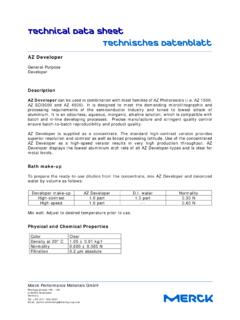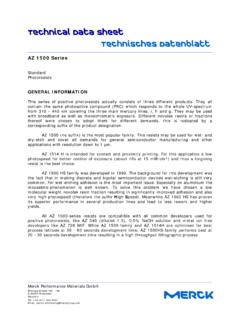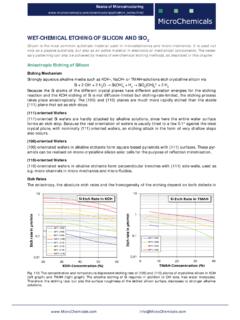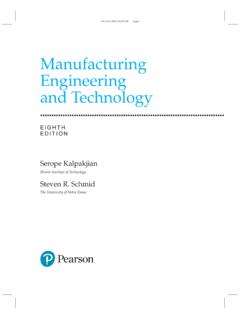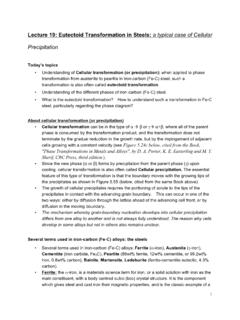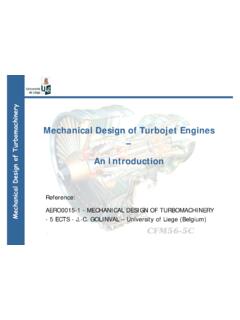Transcription of WET-CHEMICAL ETCHING OF METALS
1 Chapter01 MicroChemicals Fundamentals of of ETCHING OF METALSIn microelectronic and mechanical components, various METALS are used due to their respective electrical, opti-cal, chemical or mechanical properties. The elements aluminium, chromium, gold and copper, which can also be wet-chemically structured, are particularly chapter describes the specifi cs of the ETCHING of these METALS with diff erent ETCHING mixtures also with regard to the processing of a resist mask used for it. All substances marked with an asterisk (*) in this chapter refer to the commonly available concentration of the respective substance as listed in the last section. ETCHING of AluminiumProperties and Application Areas of AluminiumAluminium has a density of g/cm3 and therefore belongs to the light METALS .
2 Its crystal structure is cubic face centred. Due to its high electric conductivity, aluminium is used for conductors in microelec-tronics where it is often alloyed with copper in order to prevent electro-migration, or with silicon in order to prevent the formation of (silicon-consuming) aluminium-silicon a standard potential of V, aluminium does not belong to the noble METALS . However, the for-mation of a very thin (few nm) Al2O3 fi lm makes it very inert in many EtchantsTypical aluminium etchants contain 1 - 5 % HNO3* (for Al oxidation), 65 - 80 % H3PO4* for ETCHING the native aluminium oxide as well as oxide steadily newly formed by the HNO3, acetic acid to improve the wetting of the substrate with the ETCHING solution, as well as for the buff ering of the nitric acid and water to adjust the ETCHING rate at a given can also be etched with alkaline liquids, with diluted sodium or potassium hydroxide.
3 However, photoresist masks are not suitable for this since the correspondingly high pH value dissolves the resist fi lm layer in a short time or can peel it off in the case of cross-linked negative of Al EtchingThe actual aluminium ETCHING starts when, for exam-ple, using phosphoric acid as a component of typical Al- ETCHING mixtures, dissolves a few nm thick native aluminium oxide fi lm present on aluminium surfaces. For this reason, photoresist processing also impacts a subsequent Al ETCHING step:The alkaline developers preferentially dissolve the native aluminium oxide layer where the re-sist is primarily developed. These include thinner resist areas, laterally larger exposed areas or are-as which, due to diff raction or from an inho-mogeneous exposure, received a higher exposure dose.
4 Dependant on the extent of (desired or un-desired) over-developing as well as any delay be-tween development and Al- ETCHING , the process pa-rameters may lead to a laterally inhomogeneous Al ETCHING start and thus to diff erent ETCHING depths or times (Fig. 118).The formation of hydrogen in the ETCHING reaction is also problematic for a homogeneous ETCHING result. The constantly produced H2 bubbles stick to the surface and block the ETCHING process through a sup-pressed supply of fresh ETCHING medium. In this case, it can help to interrupt the ETCHING process several times by a brief dipping in water, which at least temporarily removes the H2 bubbles. lack O O SubstrateAluminiumAl2O3 Photoresist(unexposed)Photoresist(expose d)Aluminiumattack bydeveloperFig.
5 118: Alkaline developers attack the native oxide on aluminium layers where the resist is fi rst developed. There, the later, actual Al- ETCHING can begin more quick-ly than at the areas which are protected longer by the resist fi lm during development. Chapter01 MicroChemicals Fundamentals of of and SelectivityAll of our photoresists are suffi ciently stable in H3PO4/HNO3-based ETCHING mixtures to be used as a resist mask, at least after a suffi cient ETCHING rate of aluminium ETCHING based on H3PO4/HNO3 mixtures is strongly temperature-depend-ent and doubles every few degrees of temperature rise. Aluminium alloyed with only a few percent silicon has a similar ETCHING rate as pure is etched by this Al-etchant much more greatly than aluminium, nickel is comparatively weakly etched.
6 Titanium, chromium and silver are not noticeably etched, precious METALS such as gold, platinum are not etched at Aluminium EtchantOur aluminium etchant TechniEtch Al80 has the composition H3PO4* : HNO3* : CH3 COOH* : H2O = 80 %: 5 % : 5 % : 10% comes in L containers in MOS of ChromiumProperties and Application Areas of ChromiumChromium is used in the fi eld of microstructuring for the production of photo masks as well as adhesion promoters for the subsequently applied metal fi lms because of its high hardness and good adhesion to many EtchantsChromium etchants are usually based on ceric ammonium nitrate (NH4)2[Ce(NO3)6] with perchloric acid (HClO4) as an optional additive.
7 Perchloric acid is almost completely dissociated as an extremely strong acid in aqueous solution (PKS value < -8) and serves as a very strong oxidising agent for the stabilisation of the ceric ammonium nitrate. Ceric ammonium nitrate itself is a very powerful oxidising sum formula for the ETCHING of chromium with ceric ammonium nitrate and perchloric acid is3 (NH4)2Ce(NO3)6 + Cr Cr(NO3)3 + 3(NH4)2Ce(NO3)5according to which the cerium is reduced from the oxidation stage IV to III and the chromium is oxidised to oxidation stage III. The chromium nitrate, which during the ETCHING process forms a dark, constantly new formation on the chromium layer, is very soluble in water and thus in the chromate and SelectivityAll of our photoresists are suffi ciently stable in ceric ammonium nitrate and perchloric acid-based ETCHING mixtures to be used as resist , silver and vanadium are strongly etched by this ETCHING mixture.
8 Aluminium, titanium, tung-sten and nickel experience only a weak ETCHING . The noble METALS gold, platinum and palladium are not etched. Experience has shown that with copper in (electrical) contact with chromium, a greatly reduced ETCHING rate of chromium can Chromium Etchants Our chromium etchant TechniEtch Cr01 consists of ceric ammonium nitrate : Perchloric acid : water = % : % : % with an ETCHING rate of about 60 nm/minute at room temperature comes in L con-tainers in VLSI of GoldProperties and Application Areas of GoldGold is a metal of very high density of g/cm3, its crystal structure is cubic face centred. With a stand-ard potential + , gold belongs to the noble METALS .
9 The electron confi guration [Xe] 4f145 d106 s1 strongly prevents the oxidation of gold: The completely occupied 5d orbital extends beyond the single valence electron which hereby is well shielded against any reaction chemical ETCHING of gold therefore requires a strong oxidiser for the separation of the unpaired va- Chapter01 MicroChemicals Fundamentals of of electron, as well as a complexing agent which suppresses the reassembly of oxidised gold atoms back into the virtue of this high chemical stability against most acids and bases, gold is used in microelectronics as a material for electrical contacts or their ETCHING with HCl/HNO3 Mixtures of nitric acid and hydrochloric acid (in a mixing ration of 1.)
10 3 also called aqua regia are able to etch gold at room temperature. The very strong oxidative eff ect of this mixture stems from the formation of nitrosyl chloride (NOCl) via the reaction HNO3 + 3 HCl NOCl + 2 Cl + 2 H2O, while free Cl radicals formed in the solution keep the noble metal dissolved as Cl-complex (chloroauric acid = HAuCl4). Aqua regia consumes itself and decomposes under formation of nitrous gases and chlorine etch rate of aqua Regia for gold is approx. 10 m/min (at room temperature) and can be increased to several 10 m/min at elevated , aluminium, copper and molybdenum are also etched at room temperature in aqua regia. For ETCHING platinum or rhodium, the ETCHING solution has to be heated to attain a reasonable etch rate.

